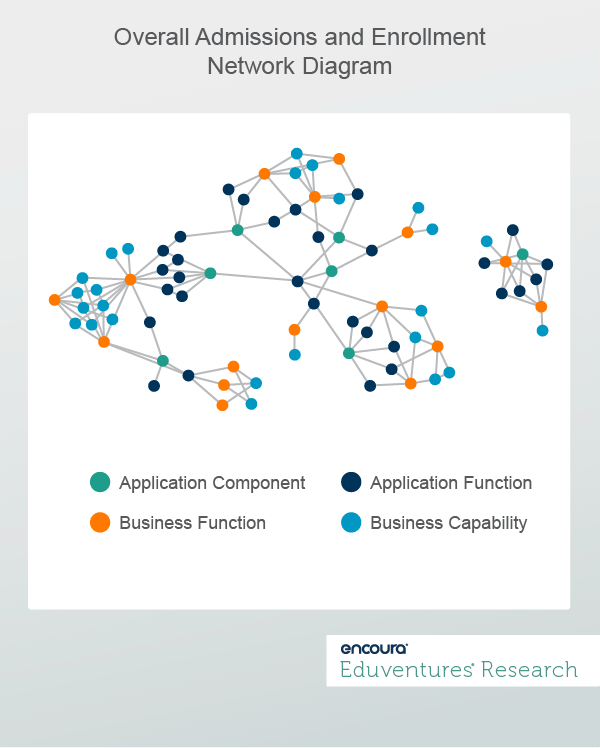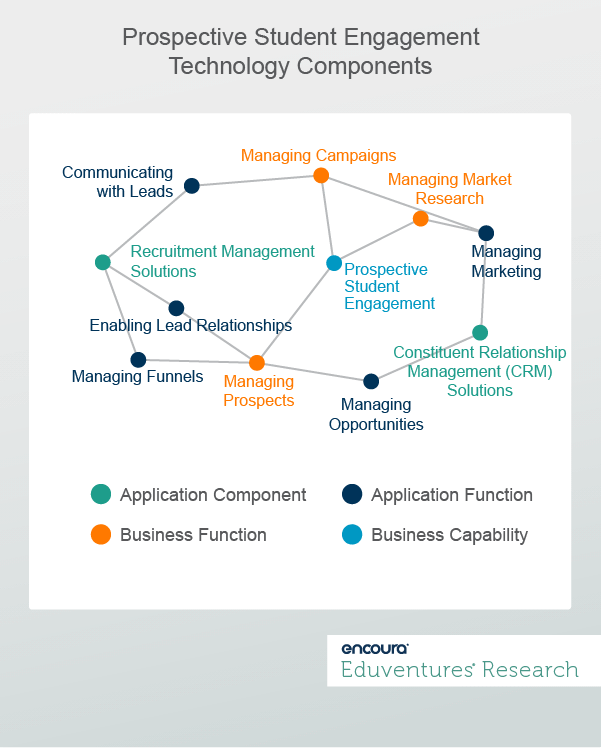When it comes to supporting the student journey, higher education leaders are like conductors of an orchestra. They have to consider which tools to use, arrange them harmoniously in an edtech ecosystem, and direct their use to address different needs.
One of our institutional partners recently spoke with us about this very challenge. To improve prospective student management and reduce melt, its leaders wanted to move beyond focusing on a given piece of technology to determine how they should marshal the different moving parts—including processes and people.
This conversation presented an interesting question that we will address in this week’s Wake-Up Call: how should leaders weave together and conduct their edtech ecosystems for maximal impact?
What are the key components?
Before addressing this question, we should first understand the critical components. We all have heard the saying that it takes people, processes, and technology to ensure the operational efficiency of a technological ecosystem. While this saying is indeed true, it does not go far enough to detail the exact required components.
For example, considering the technology solution alone—like a Learning Management System (LMS)—overlooks what specific functionality each technology should provide, such as managing content or analyzing data. Considering technology in isolation also obfuscates what capabilities and processes need to be in place to enable the technology to be successful.
Taken together, the overall view of such an ecosystem resembles the network shown in Figure 1, comprised of four key components:
- Application components: These comprise the specific technologies involved in the admissions and onboarding processes, such as Constituent Relationship Management (CRM) Solutions, Student Information Systems, and the Course Registration and Degree Planning Solutions.
- Application functions: These comprise specific behavior the technology solutions should provide, including capturing and storing content, establishing relationships with prospective students, and managing caseloads.
- Business functions: These comprise the granular activities leaders should perform, such as matching courses with programs, enabling student registration in classes, and providing academic advising.
- Business capabilities: These comprise the abilities that institutional leaders should possess, including managing campaigns, handling student records, and evaluating course availability.

To gain further insight into this network, let us revisit our client’s question and look at the specific area of engaging with prospective students. As shown in Figure 2, leaders who want to develop the capability of engaging with and promoting their institutions to prospective students have to make sure that they manage the interaction between their technologies (Constituent Relationship Management solutions and Recruitment Management Solutions), the functionality of these solutions (communicating with and developing relationships with prospects, etc.), and business functions (managing marketing campaigns, etc.).

One takeaway from this diagram is that certain application functions, such as enabling lead relationships, managing funnels, and managing opportunities, fall across different technologies. Therefore, for our partner, there was a critical decision about whether to use one technology to perform these functions or, if they chose to deploy both technologies, how they would orchestrate the application functions of each technology.
How should we conduct these components?
To ensure the coordination of different components of this edtech ecosystem, it may be helpful to consider these components as notes in a song. In this metaphor, each component taken alone may be necessary, but only has actual value when arranged with other components.
A concept may guide us here with a bit of extension: orchestration. This concept is more often applied to the world of service-oriented architecture (SOA) to indicate the optimization of workflows through the configuration, management, and coordination of computer systems, software, and services. Yet we can extend it to determine how we should consider arranging the components of an ecosystem to deliver value. According to this approach, we would take the following steps to ensure orchestration of technology components:
- Ensuring that the components are exhaustive: Just as missing notes would negatively affect a song, missing components would hinder the ability of the ecosystem to deliver value.
- Tracking the relationship of components: In such an ecosystem, leaders ensure that all components have the proper support from other components, such as having the right technology support.
- Understanding the use cases: To ensure that the ecosystem delivers value, leaders need to be clear-eyed about what needs the orchestrated ecosystem aims to satisfy, such as providing detailed financial advising to low-income students or specific advising to incoming transfer students.
Although our institutional partner is still in the process of working through how best to orchestrate its edtech ecosystem to improve student engagement and reduce melt, its leaders have centered on the first of the above steps. Their immediate goal is to determine whether they have all of the required components in place or whether they should deploy others, such as a student-facing portal.
The Bottom Line
Orchestrating an edtech ecosystem is challenging. But the key to doing it effectively is not to concentrate on the technology components alone–these are only a subset of what comprises an ecosystem. Institutional leaders should instead consider whether all the components exist for their institution and, if not, which they should add. Then—and only then—should these leaders consider how these pieces fit together to support the student journey, whether one portion of it (admissions and onboarding) or the journey overall.
Likewise, vendors should view their products as part of such an ecosystem instead of solely solving a particular pain point. Viewed this way, technology products have a greater chance of success, as institutional leaders can then see what they need to provide to empower these products to deliver on their promises. Without such an ecosystem view, we may fall victim to the “technology as a silver bullet” fallacy without seeing all the inputs to improve the student journey.
Never Miss Your Wake-Up Call
Learn more about our team of expert research analysts here.
Eduventures Principal Analyst at Encoura
Contact
Thursday, February 17, 2022 at 2PM ET/1PM CT
What will the 2022 yield season hold? This question is on every enrollment management and admissions officer's minds as we are eagerly awaiting enrollment deposits. The path ahead remains cloudy, but previous enrollment indicators can serve as a beacon for future enrollment behavior. Join us as we are mining Eduventures’ vast admitted student database for five indicators that can help us predict what the future has in store for your institution.
We will explore how different categories of higher education institutions have fared between 2019 and 2021, and predict what will happen in the spring based on five indicators:
- Type of enrollment schools: Who is benefitting from the current environment, and who will have to work harder to meet their goals?
- Enrollment reasons: How has the pandemic changed student priorities for their enrollment decisions?
- Admitted Student Mindsets™: Are your admitted students thinking differently about their pathways through college than they did before?
- Distance: How far are students willing to travel for your type of institution?
- Demographics: Which students are enrolling, who is pausing their college plans, and what does that mean for your institution?
Eduventures® 2021 Higher Education Technology Landscape (Landscape) visualizes over 300 vendors and their products, organized into over 43 separate market segments rolled up into four major categories aligned to the student lifecycle.
Throughout the year, we analyze these vendors and products and make that content available to clients. Several vendors have multiple products in their education technology portfolios.

